Altigen Communications ATGN-IP705-06 VoIP LAN Phone User Manual AltiConsole
Altigen Communications, Inc. VoIP LAN Phone AltiConsole
Manual
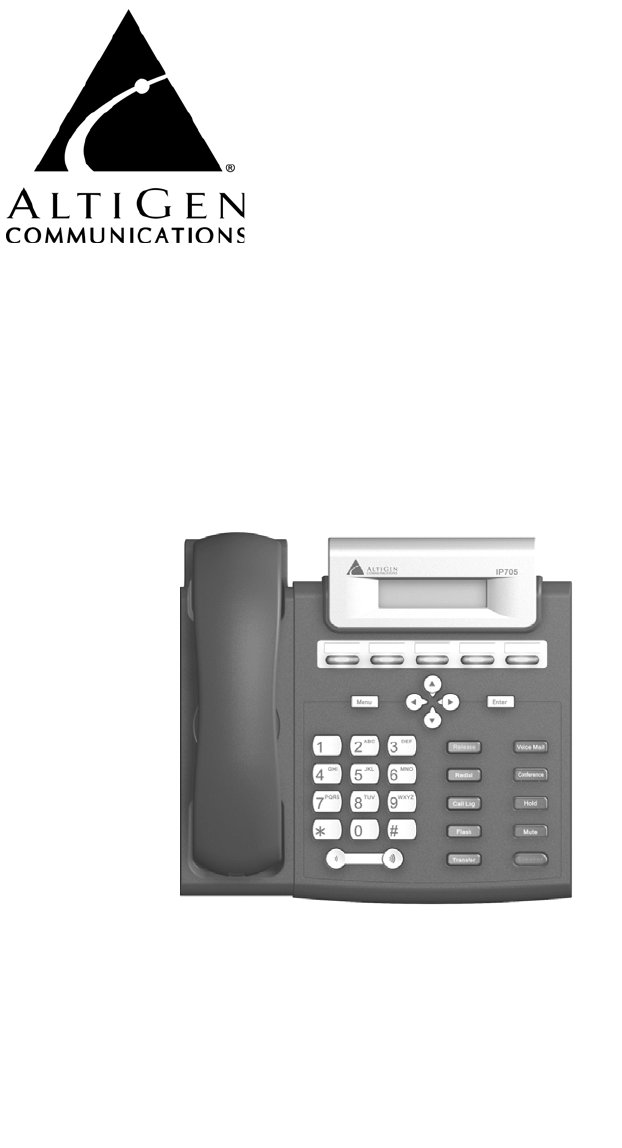
IP 705 Phone™
Administration Manual
02/2006 4290-0014-5.0A
WARNING!
Toll fraud is committed when individuals unlawfully gain access to
customer telecommunication systems. This is a criminal offense.
Currently, we do not know of any telecommunications system that is
immune to this type of criminal activity. AltiGen Communications, Inc.,
will not accept liability for any damages, including long distance charges,
which result from unauthorized and/or unlawful use. Although AltiGen
Communications, Inc., has designed security features into its products, it is
your sole responsibility to use the security features and to establish security
practices within your company, including training, security awareness, and
call auditing.
NOTICE
While every effort has been made to ensure accuracy, AltiGen
Communications, Inc., will not be liable for technical or editorial errors or
omissions contained within the documentation. The information contained
in this documentation is subject to change without notice.
This documentation may be used only in accordance with the terms of the
AltiGen Communications, Inc., License Agreement.
AltiGen Communications, Inc.
4555 Cushing Pkwy.
Fremont, CA 94538
Telephone: 510-252-9712
Fax: 510-252-9738
E-mail: info@altigen.com
Web site: www.altigen.com
TRADEMARKS
AltiGen, AltiServ, AltiWare, AltiSpan, AltiReach, AltiLink, AltiConsole,
AltiAdmin, IP 705, Zoomerang, IPTalk, AltiReport, and SuperQ are
trademarks or registered trademarks of AltiGen Communications, Inc.
All other brand names mentioned are trademarks or registered trademarks
of their respective manufacturers.
Copyright © AltiGen Communications, Inc., 2006. All rights reserved.
Printed in U.S.A. 02/2006 4290-0014-5.0A
IP 705 Manual i
Contents
Contents . . . . . . . . . . . . . . . . . . . . . . . . . . . . . . . . . . . . . . . . . . . i
Warranty . . . . . . . . . . . . . . . . . . . . . . . . . . . . . . . . . . . . . . . . . .v
About This Manual . . . . . . . . . . . . . . . . . . . . . . . . . . . . . . . . .vii
CHAPTER 1
Overview of the IP 705 . . . . . . . . . . . . . . . . . . . . . . . . . . . . . . .1
Hardware Components . . . . . . . . . . . . . . . . . . . . . . . . . . . . . . . . . . . 6
CHAPTER 2
System & Network Requirements . . . . . . . . . . . . . . . . . . . . . .7
System Requirements . . . . . . . . . . . . . . . . . . . . . . . . . . . . . . . . . . . . 7
Network Requirements . . . . . . . . . . . . . . . . . . . . . . . . . . . . . . . . . . 7
AltiAdmin/ACM Admin Configuration Requirements . . . . . . . . . . 7
AltiGen IP Phone Service . . . . . . . . . . . . . . . . . . . . . . . . . . . . . . . . 8
Plug and Play Feature . . . . . . . . . . . . . . . . . . . . . . . . . . . . . . . . . . . 8
Basic Mode . . . . . . . . . . . . . . . . . . . . . . . . . . . . . . . . . . . . . . . . . . . 8
Normal Operation . . . . . . . . . . . . . . . . . . . . . . . . . . . . . . . . . . . . . . 8
CHAPTER 3
Installation . . . . . . . . . . . . . . . . . . . . . . . . . . . . . . . . . . . . . . . . .9
Local Installation . . . . . . . . . . . . . . . . . . . . . . . . . . . . . . . . . . . . . . . 9
Remote Installation . . . . . . . . . . . . . . . . . . . . . . . . . . . . . . . . . . . . 17
Verifying the Phone Startup Process . . . . . . . . . . . . . . . . . . . . . . . 18
Other Phone Already Logged On To Extension. . . . . . . . . . . . . 19
Executing Plug and Play After IP Phone is Started . . . . . . . . . . . . 19
Restoring Default Settings . . . . . . . . . . . . . . . . . . . . . . . . . . . . . . . 20
Rebooting the IP 705 Phone . . . . . . . . . . . . . . . . . . . . . . . . . . . . . . 20
To Use IP 705 in Power over Ethernet Mode . . . . . . . . . . . . . . . . 20
To Remove the PoE Module. . . . . . . . . . . . . . . . . . . . . . . . . . . . 21
Miscellaneous Operation Notes . . . . . . . . . . . . . . . . . . . . . . . . . . . 21
ii IP 705 Manual
CHAPTER 4
Phone Configuration . . . . . . . . . . . . . . . . . . . . . . . . . . . . . . . .23
Phone Settings . . . . . . . . . . . . . . . . . . . . . . . . . . . . . . . . . . . . . . . . 23
System Settings . . . . . . . . . . . . . . . . . . . . . . . . . . . . . . . . . . . . . . . 24
Network Settings . . . . . . . . . . . . . . . . . . . . . . . . . . . . . . . . . . . . . . 25
Registration . . . . . . . . . . . . . . . . . . . . . . . . . . . . . . . . . . . . . . . . . . 26
Enabling/Disabling DHCP . . . . . . . . . . . . . . . . . . . . . . . . . . . . . . 26
Configuring IP Settings . . . . . . . . . . . . . . . . . . . . . . . . . . . . . . . . . 27
Assigning a Local IP Address . . . . . . . . . . . . . . . . . . . . . . . . . . 27
Assigning a TFTP Server . . . . . . . . . . . . . . . . . . . . . . . . . . . . . . 27
Updating Phone Firmware . . . . . . . . . . . . . . . . . . . . . . . . . . . . . . . 28
Configuring NAT . . . . . . . . . . . . . . . . . . . . . . . . . . . . . . . . . . . . . 29
Enabling NAT . . . . . . . . . . . . . . . . . . . . . . . . . . . . . . . . . . . . . . 29
Setting Ring Tones . . . . . . . . . . . . . . . . . . . . . . . . . . . . . . . . . . . . 30
Distinctive Ringing Support . . . . . . . . . . . . . . . . . . . . . . . . . 30
Workgroup Status Display . . . . . . . . . . . . . . . . . . . . . . . . . . . . . . . 31
CHAPTER 5
Phone Functions . . . . . . . . . . . . . . . . . . . . . . . . . . . . . . . . . . .33
Supported Telephony Features . . . . . . . . . . . . . . . . . . . . . . . . . . . 34
Appendix A . . . . . . . . . . . . . . . . . . . . . . . . . . . . . . . . . . . . . . .41
Specifications . . . . . . . . . . . . . . . . . . . . . . . . . . . . . . . . . . . . . . . . . 41
Firewall Considerations . . . . . . . . . . . . . . . . . . . . . . . . . . . . . . . . . 42
Troubleshooting . . . . . . . . . . . . . . . . . . . . . . . . . . . . . . . . . . . . . . . 43
LCD Messages . . . . . . . . . . . . . . . . . . . . . . . . . . . . . . . . . . . . . . . . 46
Normal Operating Mode Messages . . . . . . . . . . . . . . . . . . . . . . 46
Local Menu Configuration Messages . . . . . . . . . . . . . . . . . . . . 47
IP Phone Running Messages . . . . . . . . . . . . . . . . . . . . . . . . . . . 48
IP Phone Boot Messages . . . . . . . . . . . . . . . . . . . . . . . . . . . . . . 49
Appendix B . . . . . . . . . . . . . . . . . . . . . . . . . . . . . . . . . . . . . . .51
User Reference . . . . . . . . . . . . . . . . . . . . . . . . . . . . . . . . . . . . . . . 51
Glossary . . . . . . . . . . . . . . . . . . . . . . . . . . . . . . . . . . . . . . . . . .57
iv IP 705 Manual
NOTE
This equipment has been tested and found to comply with the limits for a
Class B digital device, pursuant to Part 15 of the FCC Rules. These limits
are designed to provide reasonable protection against harmful interference
in a residential installation. This equipment generates, uses and can radiate
radio frequency energy and, if not installed and used in accordance with the
instructions, may cause harmful interference to radio communications.
However, there is no guarantee that interference will not occur in a
particular installation. If this equipment does cause harmful interference to
radio or television reception, which can be determined by turning the
equipment off and on, the user is encouraged to try to correct the
interference by one or more of the following measures:
• Reorient or relocate the receiving antenna.
• Increase the separation between the equipment and receiver.
• Connect the equipment into an outlet on a circuit different from that to
which the receiver is connected.
• Consult the dealer or an experienced radio/TV technician for help.
Changes or modifications not expressly approved by the party responsible
for compliance could void the user’s authority to operate the equipment.
IP 705 Manual v
Warranty
What The Warranty Covers
AltiGen Communications warrants its hardware products to be free from defects in
material and workmanship during the warranty period. If a product proves to be
defective in material or workmanship during the warranty period, AltiGen
Communications will, at its sole option, repair, refund or replace the product with a
like product.
How Long the Warranty Is Effective
All AltiGen Communications products are warranted for one (1) year for all parts
from the date of the first end user purchase.
Whom the Warranty Protects
This warranty is valid only for the first end user purchaser.
What the Warranty Does Not Cover
1. Any product on which the serial number has been defaced, modified or
removed.
2. Damage, deterioration or malfunction resulting from:
a) Accident, misuse, neglect, fire, water, lightning, or other acts of nature,
unauthorized product modification, or failure to follow instructions
supplied with the product.
b) Repair or attempted repair by anyone not authorized by AltiGen
Communications.
c) Any damage of the product due to shipment.
d) Removal or installation of the product.
e) Causes external to the product, such as electric power fluctuations or
failure.
f) Use of supplies or parts not meeting AltiGen Communications’
specifications.
g) Normal wear and tear.
h) Any other cause which does not relate to a product defect.
3. Shipping, installation, set-up and removal service charges.
vi IP 705 Manual
How to Obtain Service
End user customers should contact your Authorized AltiGen Dealer for service.
Authorized AltiGen Dealers must follow the steps below for service:
1. Take or ship the product (shipment prepaid) to your AltiGen distributor or to
AltiGen Communications, Inc.
All materials being returned to AltiGen must have an associated RMA
number. RMA numbers are issued by AltiGen Customer Service and can be
obtained by calling 1-888-ALTIGEN (258-4436) or submit an online RMA
request via the AltiGen Partner Resource Center, at http://dealer.altigen.com.
AltiGen reserves the right to refuse return of any material that does not have
an RMA number. The RMA number should be clearly marked on the outside
of the box in which the material is being returned. For example:
Attn.: RMA # 123
AltiGen Communications, Inc.
4555 Cushing Pkwy.
Fremont, CA 94538
Upon authorization of return, AltiGen will decide whether the
malfunctioning product will be repaired or replaced.
2. To obtain warranty service, you will be required to provide:
a) The date and proof of purchase
b) Serial number of the product
c) Your name and company name
d) Your shipping address
e) A description of the problem
3. For additional information contact your AltiGen Dealer or AltiGen
Communications, Inc.
Effect of State Law
This warranty gives you specific legal rights, and you may also have other rights
which vary from state to state. Some states do not allow limitations on implied
warranties and/or do not allow the exclusion of incidental or consequential
damages, so the above limitations and exclusions may not apply to you.
Sales Outside the U.S.A.
For AltiGen Communications products sold outside of the U.S.A., contact your
AltiGen Communications dealer for warranty information and services.
IP 705 Manual vii
About This Manual
This manual describes how to get the Alti-IP 705 phone up and running on
a voice over IP (VoIP) network. It provides information about how to set
up, connect cables to, and configure an IP 705 phone. It also provides
information on how to configure the network and IP settings.
Related Documentation
•IP 705 Quick Reference Card covers basic end user phone features,
configuration from the IP phone, and AltiServ feature codes.
•AltiWare OE/ACC System Installation and Administration Manual or
AltiContact Manager System Administration Manual provides
complete and detailed information on procedures that you need to
perform on AltiGen’s AltiWare application or other network devices.
viii IP 705 Manual
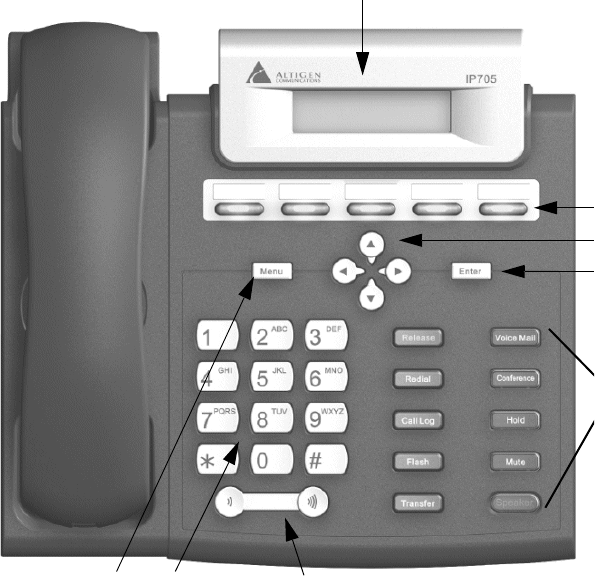
IP 705 Manual 1
C
HAPTER
1
Overview of the IP 705
The AltiGen IP 705 phone is a business telephone that provides voice
communication over an IP network.
The IP 705 provides functionality similar to traditional business phones,
including automatic redial, on-hook dialing, hands-free operation, 5
programmable keys, LCD display and headset port support.
The main components of the phone are illustrated in the figures below and
described in the table that follows each figure.
Figure 1. IP 705 Phone, Top View
1
15
16
17
2
3
4
5 - 14

2IP 705 Manual
1LCD Screen Displays features such as time, extension number,
caller ID, call waiting, line/call status and call
duration. Displays the phone’s menu.
2Program-
mable Keys*
1-5
5 programmable keys can be configured by the
system administrator in AltiAdmin/ACM Admin as
a Busy Lamp Field (BLF) key, an AltiServ Feature
Code key, an Admin Defined # key, an EXT Speed
Dial key, a Line Park key, a Call Record key, a
User Defined # key, or a Headset key.
3Navigation
buttons
/buttons let you scroll through text on the LCD
screen.
button selects a menu item or setting.
button returns to previous configuration menu or
deletes the last digit input.
4Enter Confirms selections made in the LCD, including
settings.
5Voice Mail* Lights when a message is waiting. Enters voice mail
when pressed.
6Conference* Initiates a conference call, indicated by the button’s
blinking light.
7Hold* Places a call on hold, indicated by the button’s
blinking light.
8Mute Engages or disengages mute function.
9Speaker Enables or disables speaker.
10 Release Releases a call, exits from the menu, releases phone
from an active state.
11 Redial* Redials up to last 16 calls and up to 32 digits.
12 Call Log* Displays the caller IDs of up to 99 incoming calls.
Dials selected number.

Overview of the IP 705
IP 705 Manual 3
Note: * Indicates a normal operating mode key feature, which is
available only after registering the IP 705 with the phone server
and logged in as an extension.
13 Flash* For system feature codes that need a flash to
complete.
14 Transfer* Transfers a call.
15 Volume Adjusts volume of ringer, speaker, handset and
headset.
16 Dial Pad Functions like a dial pad on a traditional telephone
and is also used for inputting some settings that are
accessed through the phone’s menu.
17 Menu Displays the phone’s menu in the LCD screen.
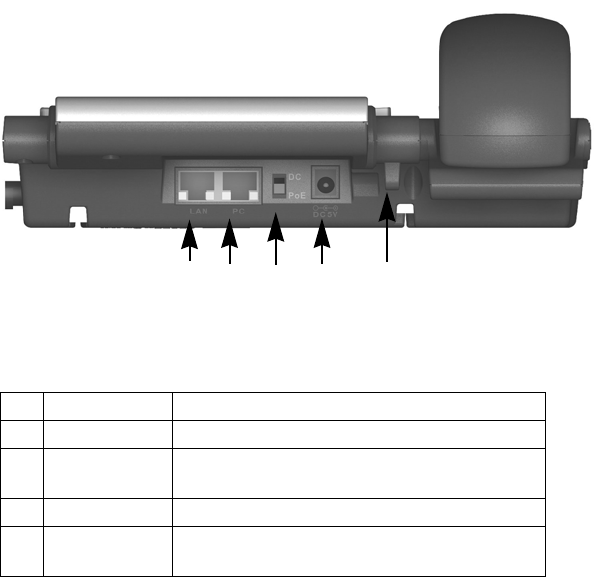
4IP 705 Manual
Figure 2. IP 705 Phone, Back View
1LAN Port Connects to network (10/100 Base T)
2PC Access Port Connects to a PC (10/100 Base T)
3DC/PoE Switch Switches between DC power and power over
Ethernet
4DC Port Connects to power outlet
5Power Cable
Restraint
Secures the power cable, preventing it from
accidentally being pulled out
5
12 34
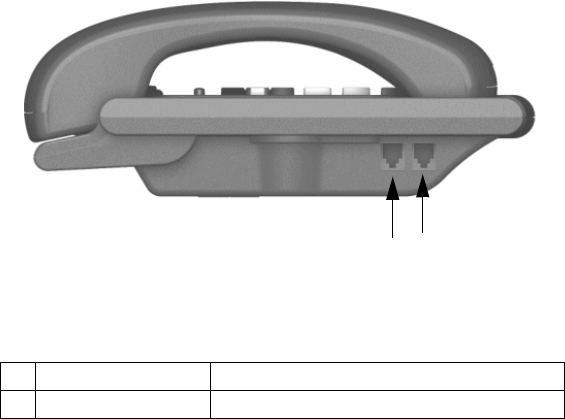
Overview of the IP 705
IP 705 Manual 5
Figure 3. IP 705 Phone, Left View
1Headset port Connects to an RJ-9 headset
2Handset RJ-9 Port Connects to a handset
12
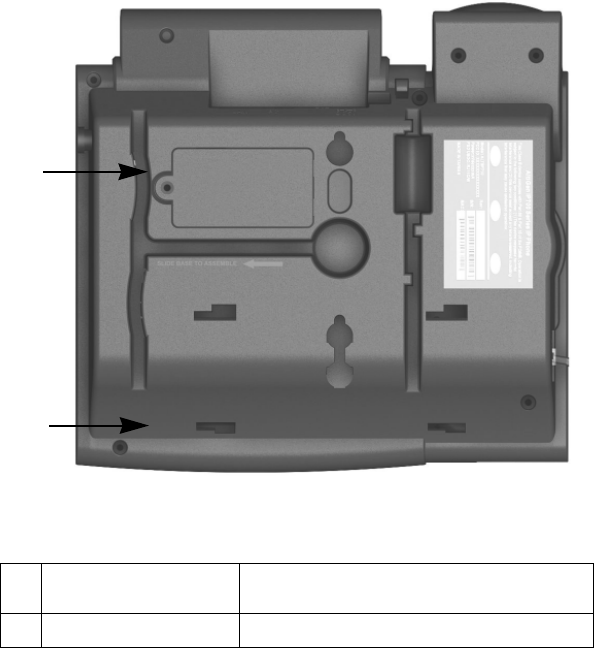
6IP 705 Manual
Figure 4. IP 705 Phone, Bottom View
Hardware Components
The following hardware items are included in this package:
• IP 705 set and stand
• Handset
• Handset cord
• AC adapter (Input: 100-240V; Output: DC 5V, 2A)
• Power cord
• Network cable
Optional item can be purchased separately:
• Power over Ethernet (PoE) module
1PoE Module Cover Covers the optional Power over Ethernet
Module
2Slots for the phone stand Two slots to insert the phone stand
1
2
IP 705 Manual 7
C
HAPTER
2
System & Network Requirements
System Requirements
• AltiWare OE 5.0A Update 4 or higher
• AltiGen OE 5.0A GateKeeper or higher (to support plug and play
functionality)
Network Requirements
• Network connection — the IP phone must have TCP/IP connection to
the related AltiWare system
Important: Make sure a Layer 3 Managed Ethernet switch is used,
rather than a hub, in the corporate LAN. A Layer 3
Managed Ethernet switch provides adequate Quality of
Service for VoIP deployment.
• DHCP Server (to get an IP address dynamically, when necessary)
• TFTP Server (to update the IP phone firmware, when necessary)
• GateKeeper (for plug and play feature)
AltiAdmin/ACM Admin Configuration
Requirements
• The IP 705 requires an IP extension to be enabled in AltiAdmin to
handle call processing. Refer to the “Setting Up IP Extensions” chapter
in the AltiWare OE/ACC System Installation & Administration
Manual or ACM System Administration Manual for detailed
instructions on how to set up an IP extension to manage the IP phone.
• The IP phone settings must be pre-configured in AltiAdmin/ACM
Admin before setting up configuration for the IP 705.
8IP 705 Manual
AltiGen IP Phone Service
AltiGen IP Phone Service is installed together with AltiWare and connects
to AltiWare through enhanced AltiLink+ protocol on behalf of IP 705
phones. This service must be running for the IP 705 to operate. If IP Phone
Service stops while the IP 705 is on a call, the call will be disconnected.
Plug and Play Feature
The IP 705 supports a plug and play feature when running AltiWare. When
the phone is first booted up, this feature enables the phone to automatically
discover the AltiServ IP address, instead of having to program the phone
manually. Refer to “Important Notes for Plug and Play” on page 9 for
requirements and setup.
Note: The plug and play feature requires AltiGateKeeper Discovery and
a single gatekeeper on the LAN.
Basic Mode
The IP 705 operates in Basic mode if it fails to register with AltiWare
during startup. When in Basic mode, the IP phone’s LCD display shows
(BASIC) IDLE. No AltiWare switching features are available in this
operating mode. However, the phone user can enter a destination IP address
followed by #, and make an outgoing call through the IP network to reach
AltiWare or another IP 705 phone. Also, the IP phone can accept incoming
calls originating from AltiWare or another IP 705 phone.
Normal Operation
In normal operating mode, the IP 705 should have been registered with the
phone server and logged in as an extension. The time and extension appear
in the LCD screen and all phone features are enabled.
Note: To enable the IP 705 to work in normal operating mode, open the
firewall port 10032 for the phone server. Refer to the AltiWare OE/
ACC System Installation & Administration Manual or ACM
System Administration Manual for information on other firewall
ports for H.323.
IP 705 Manual 9
C
HAPTER
3
Installation
This chapter describes local installation and remote installation of the
IP 705 phone.
Important Notes for Plug and Play
A plug and play feature enables the IP 705 phone to automatically discover
the AltiServ IP address.
• To use the plug and play feature, the user’s IP phone must be on the
LAN with AltiServ.
• There can be only one AltiServ on the LAN.
• An instance of AltiGen GateKeeper needs to be running on the LAN
and configured to point to the AltiWare system.
• GateKeeper Auto Discovery uses broadcast UDP packets, which work
in the LAN or VPN environment, but not through the public IP
network.
• The DHCP server must be up and running.
Local Installation
1. Gather network settings information (this information will be needed
to configure the IP 705):
• AltiWare server IP address
If you are not using GateKeeper Auto Discovery – needed for plug
and play – you will have to manually configure the AltiServ IP
address on your IP phones.
• IP 705 phone’s IP address
This address is needed if DHCP is not used. It can be obtained
from the system administrator.
• Firewall information
See “Firewall Considerations” on page 42, if a firewall is being
used in the AltiWare environment.
10 IP 705 Manual
2. Ensure that there are enough IP addresses for all IP phones and that
enough physical extension licenses are available.
3. If using plug and play, click the Extension button to display the
Extension Configuration window, and ensure that there is an available
virtual extension with Enable IP Extension checked, and Dynamic
IP Address selected.
4. In the Extension Configuration window, create an extension with
Enable IP Extension checked.
5. Choose System Management > VoIP Configuration, and click the
VoIP Codec Configuration tab to configure codec settings: If G711
is used, assign an IP phone network address range for G711 codec.
6. Choose System Management > AltiGen IP Phone Configuration
to configure the IP phone.
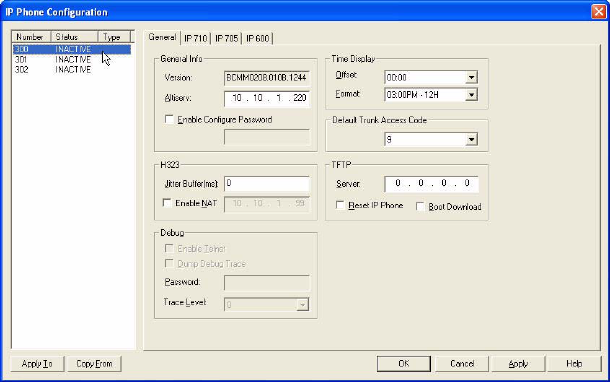
Installation
IP 705 Manual 11
This opens the IP Phone Configuration window:
The left side of the IP Phone Configuration window displays all the
IP phones that have been set up in the system. The following table
describes the parameters on the General tab:
Parameter Description
General
Info Lets you specify the IP address of the AltiServ system
that the IP 705 phone is connected to. The version of
software associated with AltiServ is automatically
displayed in the Version field.
To allow the extension user to have password-
protected configuration functionality from the phone
itself, check the Enable Configure Password check
box and assign a numerical password. When the
extension user attempts to configure features, the user
will need to enter the assigned password to proceed.
H.323 Lets you set the Jitter Buffer—the delay used to
buffer voice packets received from the IP network—in
milliseconds. The Jitter Buffer should be adjusted
according to the WAN bandwidth allocated to data
traffic.
To allow NAT support for the IP extension, check the
Enable NAT check box.
12 IP 705 Manual
Note: The Apply To button works with the following parameters:
General, H.323, TFTP Server field (Reset IP Phone and Boot
Download options cannot be applied to multiple extensions),
and Debug.
Time
Display •Offset - a per phone-based configuration. Allows
the phone to display a different time, based on
location.
•Format - a per-phone-based configuration. Allows
the phone to display 24-hour or 12-hour (AM/PM)
format.
Trunk
Access
Code
• Lets you set the digit required to enable a user to
return an outside call from the Call Log.
• The default trunk access code is the route access
code, if it is set in AltiAdmin/ACM Admin.
• This setting also appears on the phone’s SYSTEM
menu.
TFTP Lets you assign the TFTP Server to which the IP phone
can connect for updating firmware when necessary.
Enter the IP address of the TFTP Server in the Server
field.
To update the IP phone image, the administrator can
check the Reset IP Phone and Boot Download check
box options to reset and download the image to update
the phone.
Debug When enabled, allows the IP 705 phone to connect to
Telnet for debugging.
Parameter Description
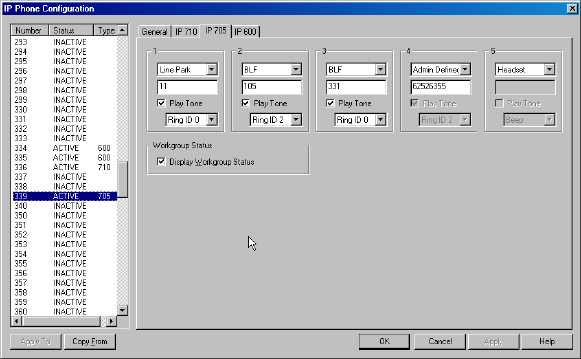
Installation
IP 705 Manual 13
After creating IP extensions, and setting parameters on the
General tab, go to the IP 705 tab:
The parameters on the IP 705 tab are described in the next table.
14 IP 705 Manual
Parameter Description
Program-
mable
Keys 1 - 5
Corresponds to the 5 programmable keys on the IP 705.
Use the drop-down lists to assign one of the following
functions to the desired keys:
•N/A - when selected, the corresponding
programmable key cannot be used.
•BLF (Busy Lamp Field) - when selected, enter an
extension number in the field below; this will be
associated with the corresponding programmable
key to automatically dial this extension number; the
light in this programmable key indicates that the
extension number is busy. You can select the Play
Tone check box to also have the IP phone play an
audible beep or one of 5 different ring tones when
the extension number is ringing.
Note: The BLF feature can be assigned only to
internal extension numbers, not outside
numbers.
•Feature Code - when selected, enter an AltiServ
feature code in the field below; this will be
associated with the corresponding programmable
key to dial this feature code.
•Admin Defined # - when selected, enter the speed
dial code in the field below; this will be associated
with the corresponding programmable key to dial
this speed dial code.
•EXT Speed Dial - when selected, allows the user to
press the function key from the IP phone to access
the IP extension's station speed dial directory, using
the / buttons to scroll through the list, then
going off-hook or pressing the Speaker button to
call the number. The extension’s station speed dial
can be configured through AltiView/AltiAgent or
AltiAdmin/ACM Admin.
•Line Park - when selected, use the drop-down list
to select the desired Line Park line ID.
Installation
IP 705 Manual 15
IMPORTANT!
When the IP 705 phone is registered with the system, its local
configuration is overridden by the configuration in AltiAdmin/
ACM Admin. However, once the IP phone is successfully
registered, configuration changes made on the phone override
the AltiWare IP address and network-related settings on the
server.
If the IP phone’s local configuration is changed while in Basic
mode, the changes are overridden by AltiAdmin/ACM Admin
settings.
Program-
mable
Keys 1 - 5
(cont.)
•Call Record - when selected, the IP phone user can
start and/or stop voice recording on demand. In the
Extension Configuration screen on the General
page, Record on Demand to Extension VM or
Record on Demand to Central Location must be
enabled in the Call Recording Options field. Press
the key to start recording, press the key again to stop
recording. There is no pause function. When the call
is recording, the light will be on. Recorded
conversations can then be played back through
voice mail or accessed at a centralized location.
WARNING!
Listening in to or recording a conversation without
the consent of one or both parties may be a
violation of local, state and federal privacy laws. It
is the responsibility of the users of this feature to
assure they are in compliance with all applicable
laws.
•User Defined # - when selected, the IP phone user
will be able to program the corresponding
programmable key as a speed dial or feature code
key directly from the IP phone menu: PHONE
SETTING > PROGRAM KEYS > PROGRAM KEY.
•Headset - (available in function key 5) when
selected, the IP phone user will be able to activate a
the headset port.
Parameter Description

16 IP 705 Manual
7. Connect the IP 705:
a. Connect the phone to the LAN that AltiServ is on.
b. Connect the handset to the handset port.
c. Connect the power plug to the DC port.
Note: If you want to use Power over Ethernet, see “To Use IP 705
in Power over Ethernet Mode” on page 20.
8. Configure startup network settings:
If you are using DHCP, ensure that DHCP is enabled on the IP 705
phone: Menu > NETWORK > ENABLE DHCP > Yes. (DHCP is
enabled by default.)
If you are not using DHCP, you must configure these network settings
on the IP 705 after installing the phone on the network:
• Local IP address
• IP subnet mask
• Gateway IP address
9. Configure the AltiWare IP settings:
If you are using GateKeeper Auto Discovery, you do not need to
configure anything. Proceed to Step 9.
If you are not using GateKeeper Auto Discovery, you must manually
configure the AltiWare IP address setting into the IP 705 phone:
a. Menu > SYSTEM >Enter.
b. Select AW SERVER, and press Enter.
c. Enter the AltiWare server address, using the * key to input periods,
and press Enter.
10. Activate the IP 705 extension from the IP phone:
a. With the handset onhook, press #27, then the Enter button.
b. Enter the extension number and password when prompted.
c. The phone will attempt to register, as shown in the LCD screen:

Installation
IP 705 Manual 17
If the phone successfully passes through these stages, the phone
shows the time and extension in the LCD screen and is now in normal
operating mode.
If it doesn’t pass through these stages successfully, refer to
“Troubleshooting” on page 43.
Remote Installation
To install the IP 705 phone at a remote location, using a broadband
connection with or without a router:
1. In the firewall at the corporate network, open TCP/UDP ports
required by the IP 705. (For a listing of these ports, refer to “Firewall
Considerations” on page 42.)
2. Check the AltiWare server’s IP extension settings. Make sure
Dynamic IP Address is checked, enough physical extension licenses
are available, and that the proper codec setting is configured.
3. If DHCP is not used, configure the phone’s local IP address and
Gateway IP address. (Depending on the Internet Service Provider’s
recommendations, you may or may not want to use DHCP.)
a. Press the Menu button, scroll to NETWORK, and press the Enter
button.
b. Scroll to LOCAL ADDRESS, then press Enter.
c. Enter the IP address, using the * key to input periods, then press
Enter.
4. If the IP phone is behind a NAT router, return to the NETWORK menu
and set the ENABLE NAT setting to YES.
5. If the IP phone is behind a NAT router, configure the router’s DMZ
to point to the private IP address of the IP phone.
6. If AltiServ is behind a NAT router, configure the router to forward the
following ports to AltiServ’s private IP address:
• TCP port 10032 (for phone service)
• TCP port 1720 (for H.225)
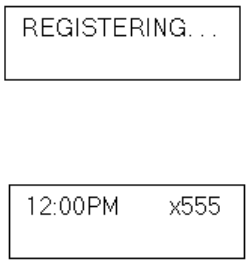
18 IP 705 Manual
• TCP/UDP 49152 ~ N (for H.245 and RTP/RTCP); where N =
49152 + (62 * number of VoIP boards) - 1.
7. Configure the IP 705 phone’s AltiWare address:
a. Press the Menu button, scroll to SYSTEM, and press Enter.
b. Select AW SERVER, and press Enter.
c. Enter the AltiWare server address, using the * key to input periods,
and press Enter.
8. Exit the menu, using the Release button or the button.
9. Press #27 then press Enter to initiate logging onto AltiServ.
10. The phone will attempt to register as shown in the LCD screen.
If the phone successfully passes through these stages, the phone
shows the time and extension in the LCD screen and is now in normal
operating mode.
If it doesn’t, refer to “Troubleshooting” on page 43.
Note: When the IP 705 phone registers with AltiServ, the AltiWare
IP address, TFTP (IP) address, and other network-related
configuration parameters override the settings in AltiAdmin.
Other parameters, such as hour offset, trunk access code, and
debug are overridden by the settings in AltiAdmin.
11. Set up IP phone properties in AltiWare as described in step
6 on page 10.
Verifying the Phone Startup Process
After the IP 705 has power connected to it, the phone begins its automatic
booting process by cycling through these steps:
1. All LED lights will be on.
2. The LCD screen displays [ATGN BOOT] on the first line.

Installation
IP 705 Manual 19
3. On the second line of the LCD screen, the following messages are
displayed in succession:
—CHECK MEMORY (RAM checking state)
—CHECK FW (Firmware checking state)
—INIT NETWORK
—LOADING FW...
—LOADING NOW.
—Boot Done
—INITIALIZING
—Version 060D.010B.1442
If the phone successfully passes through these stages, it has started up
properly. If it doesn’t, refer to “Troubleshooting” on page 43.
Other Phone Already Logged On To Extension
If another analog phone or IP phone is already logged on to the same
extension, rebooting the IP 705 will not register the phone successfully.
The user must press #27 on the IP phone to actively log on to AltiServ.
After the extension is logged on and activated, the calls are redirected to
this IP phone.
Important: The user should not use the VM option to log on to the IP 705
phone.
Executing Plug and Play After IP Phone is
Started
If you have already started the IP phone and want to execute the plug and
play feature, perform the following steps:
1. Power up the IP phone (the phone should be in Basic mode).
2. Press the Menu button.
3. Press * * 2 then the Enter button to restore default settings.

20 IP 705 Manual
4. Reboot the phone (by unplugging the power and replugging OR
pressing * * 3 then Enter).
5. Enter extension number and password.
6. The time and extension are displayed in the first line of the LCD
screen after the phone has been successfully logged on to AltiServ.
Restoring Default Settings
To automatically restore the original default settings for the IP 705 phone:
1. Press the Menu button.
2. Press * * 2, then press the Enter button.
Rebooting the IP 705 Phone
To reboot the IP 705, press * * 3, then press the Enter button.
Note: When the IP 705 is rebooted, the AltiWare IP address setting
reverts to the original configuration.
To Use IP 705 in Power over Ethernet Mode
1. Unplug the power cord.
2. Remove the screw on the PoE Module cover, and remove the cover.
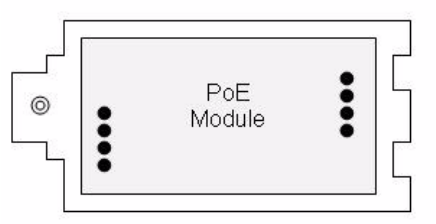
Installation
IP 705 Manual 21
3. Plug in the PoE Module as illustrated below. The side with four pins
in the center faces the right side.
4. Put the PoE module cover back, and tighten the screw.
5. Move the DC/PoE switch to the PoE position.
6. Connect the phone to an AltiGen-certified PoE-enabled switch.
To Remove the PoE Module
1. Remove the screw on the PoE Module cover, and remove the cover.
2. Notice the “feet” on the two tabs that are located on the lower end of
the cover. Use these feet to lift the PoE module out of the
compartment, like this: Holding the upper end of the cover, slip the
cover into either the right side or left side of the module compartment,
between the compartment and the module, until the feet of the two
tabs is under the module (the inside of the cover should be facing
toward the module).
3. Pull up to remove the module.
Miscellaneous Operation Notes
• When using #26 and #27 to log out / log in, the IP 705 must be onhook.
Pressing the Speaker button and then using #26 or #27 will not work.
• Two dial tones are always heard when going offhook on the IP 705.
• If the IP 705 is configured for a public IP address, you can call other
public IP address devices.
• If the IP 705 is configured for a private IP address, you can call other
private IP address devices that you can “see” or that are on your subnet.
Right
Left
22 IP 705 Manual
• The daisy chaining of IP 705 phones is not supported.
• If two calls ring into the IP 705 at the same time and the user attempts
to answer the second call, the IP phone will automatically connect the
user to the first call.
• If a call comes in while any phone menu or display (such as workgroup
display or Call Log) is being used, the phone will exit the menu and go
to the ring state.

Phone Configuration
IP 705 Manual 23
C
HAPTER
4
Phone Configuration
Phone, system, and network settings can be configured through the IP
phone’s menu. The phone can also be registered through this menu, if
necessary.
• To get to the menu, press the Menu button.
•/ buttons scroll the menus and settings in the LCD screen.
• button selects a menu item or a setting.
• The Enter button also selects a menu item or a setting.
• button returns to the previous menu.
•Press the Release button to exit the menu.
The following tables describe each setting and the corresponding menu
path.
Important: The configuration in AltiAdmin will override the IP 705
phone’s local configuration after the IP phone is registered.
If the IP phone’s local configuration is changed while in
Basic mode, these changes will be overwritten by AltiAdmin
settings. Also, after the IP phone is successfully registered
with AltiServ, the IP phone will overwrite the AltiWare IP
address and network-related settings on the server.
Note: Several of these settings can be configured through AltiAdmin by
the system administrator.
Phone Settings
Setting Menu Path Description
Extension
Number
Phone Setting >
Ext Number
Sets the IP phone’s extension
number.
Extension
Password
Phone Setting >
Ext Password
Sets the IP phone’s extension
password.

24 IP 705 Manual
System Settings
Program
Keys
Phone Setting >
Program Keys >
Program Key [#]
Sets the speed dial number or feature
code for a selected key.
Ring Tone Phone Setting >
Ring Tones
Sets the desired ring tone.
Ring
Download
Phone Setting >
Ring Download
Downloads ring tones from the
server.
Auto Answer Phone Setting >
Auto Answer
Sets whether to enable automatic
answering.
Auto Answer
Ring
Phone Setting >
Auto Ans Ring
Sets how many seconds the phone
should ring before it is automatically
answered. Appears on menu when
Auto Answer is set to Yes.
Auto Answer
Device
Phone Setting >
Auto Ans Dev
Sets whether speaker or headset is
the automatic answering device.
Appears on menu when Auto
Answer is set to Yes.
Setting Menu Path Description
AltiWare
Server
System > AW Server Sets the AltiWare server’s IP
address.
Trunk
Access Code
SYSTEM >
TRK ACCESS CODE
Sets the digit required to enable a
user to return an outside call from the
Call Log.
Hour Offset System >
Hour Offset
Sets the time offset from the
AltiWare server’s time.
TFTP Server System >
TFTP Server
Sets the TFTP server IP address for
updating firmware.

Phone Configuration
IP 705 Manual 25
Network Settings
Boot
Download
System >
Boot Download
After firmware image upgrade, this
setting changes to No. Used mainly
for upgrading or troubleshooting. On
the next boot, the IP phone will
download the new firmware from the
TFTP server, if set to Yes.
Emergency
Number
System >
Emergency Num
Sets the IP phone’s emergency
number. For the U.S., the emergency
number is 911.
Emergency
Gateway
System >
Emergency GW
Sets the IP phone’s emergency
gateway IP address
Version
Information
System >
Version Info
[Read only]
Displays the version number of the
IP phone.
Setting Menu Path Description
Enable DHCP Network >
Enable DHCP
Sets whether Dynamic Host
Configuration Protocol (DHCP) is
being used by the IP phone to retrieve
a new IP address upon boot up.
Local
Address
Network >
Local Address
Sets the IP phone’s local address;
shows only if DHCP is disabled.
Network
Mask
Network >
Network Mask
Sets the IP phone’s network mask;
shows only if DHCP is disabled.
Gateway Network >
Gateway
Sets the default Gateway IP address.
Enable
GateKeeper
Network >
Enable GK
Sets whether GateKeeper is enabled
or disabled.
GateKeeper
Discovery
Network >
GK Discovery
Sets whether GateKeeper discovery is
enabled. IP phone will automatically
find GateKeeper. Shows only if
GateKeeper is enabled.

26 IP 705 Manual
Registration
Under normal circumstances, the IP 705 phone registers itself
automatically. However, if registration failed for some reason (for
example, the server was not available), registration can be started again
from the IP 705 phone’s menu:
1. Press the Menu button.
2. Scroll to REGISTER.
3. Press the Enter button.
Enabling/Disabling DHCP
Dynamic Host Configuration Protocol (DHCP) automatically assigns IP
addresses to devices when they are connected to the network. The IP 705
enables DHCP by default. If you do not use DHCP in your network, you
can disable DHCP before manually assigning an IP address to the IP 705.
Note: Procedures involving configuring IP settings cannot be completed
when DHCP is enabled on the IP phone.
To enable/disable DHCP, follow these steps:
1. Press the Menu button.
2. Press the button to select NETWORK, then press the Enter button.
3. Scroll to ENABLE DHCP, then press Enter.
4. Press / to toggle to YES or NO and press Enter.
5. Restart the phone to obtain IP confirmation information from the
DHCP server
Enable NAT Network >
Enable NAT
Sets whether NAT is enabled or
disabled.
NAT Address Network >
NAT Address
Sets the NAT server’s public IP
address.
Phone Configuration
IP 705 Manual 27
Configuring IP Settings
Use these guidelines when manually configuring the IP settings:
• Ensure the default gateway IP address is on the same subnet as the host
IP address.
• When inputting IP addresses into the IP 705, use the * key to enter
periods. For example, 209.120.12.8 would be input as 209*120*12*8.
Assigning a Local IP Address
The IP address is the unique logical address identifying each host computer
on a TCP/IP network. An IP address is a 32-bit number expressed as four
decimal numbers from 0 to 255, separated by periods.
To assign an IP address, use the following steps:
1. Ensure that DHCP is disabled (refer to “Enabling/Disabling DHCP”
on page 26).
2. Press the Menu button, scroll to NETWORK, then press the Enter
button.
3. Scroll to LOCAL ADDRESS, and press Enter.
4. Use the keys on the dial pad to enter a new IP address, using the * key
to enter periods.
5. Press Enter.
Assigning a TFTP Server
The default TFTP Server is set to 0.0.0.0.
To assign the TFTP server, use the following steps:
1. Press the Menu button.
2. Use / to select System, then press the Enter button.
3. Scroll to TFTP Server, and press Enter.
4. Use the keys on the dial pad to enter the new TFTP server address,
using the * key to enter periods, then press Enter.
28 IP 705 Manual
Updating Phone Firmware
Note: If using TFTP Server Application, TFTPD32, included in the CD-
ROM, copy tftpd32.exe and the associated .hlp and .gid
files to a local directory; after they are copied, you can launch the
TFTP Server application from the executable file.
Obtain app_705.bin and dsp.bin files from the AltiGen
website and copy to the same local directory where you copied
tftpd32.exe.
Important: When updating the IP 705 phone’s firmware, it is
recommended that administrators perform any updates after
normal business hours or when the IP phone is not in use. If
the IP 705 phone is in use during an update, the call will be
disconnected.
If the IP 705 phone is registered with AltiServ, to update the phone
firmware from AltiAdmin, do the following:
1. Launch IP Phone Configuration in AltiAdmin Main Menu.
2. Set the TFTP Server address.
3. Select Boot Download and Reset IP Phone check boxes, then click
Apply.
4. The IP 705 should reboot and download the image from the specified
TFTP server.
To update the phone firmware directly from the IP 705 phone, follow these
steps:
1. Press the Menu button.
2. Use the button to scroll to System, then press the Enter button.
3. Scroll to TFTP Server, then press Enter.
4. Enter the TFTP server address, using the * key to input periods.
5. The IP 705 will download the firmware from the TFTP server on the
next reboot.
6. Reboot by unplugging and replugging the power cable OR by
pressing * * 3 and the Enter button.
7. Once the IP phone is rebooted, all LED lights come on for a brief
time.
8. The LCD screen displays [BOOTING] on the first line.
Phone Configuration
IP 705 Manual 29
9. On the second line of the LCD screen, the following messages are
displayed in succession:
—CHECK MEMORY (RAM checking state)
—CHECK FW (Firmware checking state)
—INIT NETWORK
—LOADING FW...
—LOADING NOW.
—Boot Done
—INITIALIZING
—Version 060D.010B.1442
10. You may display the version of firmware at any time: Press the Menu
button, scroll to SYSTEM and press Enter, scroll to Version Info
and press Enter.
Configuring NAT
NAT (Network Address Translation) is the translation of an IP address
used within one network to a different IP address known within another
network. One network is designated as the inside network, the other is the
outside. The IP 705 can be enabled to support H.323 behind NAT. The IP
705 will be able to work behind a regular NAT router without any special
implementation for H.323.
For more detailed information regarding NAT configuration guidelines and
implementation, refer to the AltiWare OE/ACC or ACM System
Administration Manual.
Note: If more than one IP 705 phone sits behind NAT, a VPN tunnel is
required to connect between the NAT router and the corporate
router.
Enabling NAT
By default, NAT is not enabled. If you connect the IP 705 behind a NAT
router, you must enable NAT.
To enable NAT,
30 IP 705 Manual
1. Press the Menu button.
2. Use the button to scroll to NETWORK, then press the Enter button.
3. Scroll to ENABLE NAT, and press Enter.
4. Press to select YES, and press Enter.
Setting Ring Tones
To set the ring tone:
1. Press the Menu button.
2. Select PHONE SETTING, then press the Enter button.
3. Scroll to RING TONES and press Enter.
4. Scroll to the desired ring tone and press Enter.
When new ring tones are added to the server, they can be downloaded from
the phone. To download ring tones:
1. Select PHONE SETTING and press Enter.
2. Select RING DOWNLOAD and press Enter.
3. Select YES and press Enter.
4. Reboot the phone by pressing * * 3 and the Enter button.
Note: Custom ring tones are not supported.
Distinctive Ringing Support
If the Distinctive Ring options are enabled by the system administrator in
AltiAdmin/ACM Admin (General page of System Configuration), you
may have three different ring cadences that distinguish the types of calls:
• Internal call = 1 ring
• External call = 2 rings
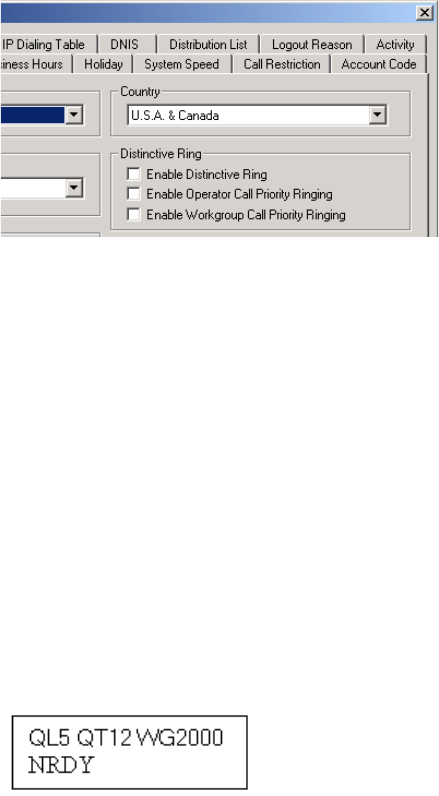
Phone Configuration
IP 705 Manual 31
• Operator call = 3 rings
Figure 5. Distinctive Ring Options, General Page, System Configuration
Workgroup Status Display
The AltiGen IP phone can be enabled to display workgroup status.
While the agent is in idle state, the first line in the LCD displays:
•QL = number of workgroup queued calls (up to 99)
•QT = current longest queue time (in minutes)
•WG = last four digits of the workgroup number
The second line in the LCD displays one of the following agent states:
•LOUT - logout
•NRDY - not ready
•DND - do not disturb
•FWD - forwarding
Note: The area is blank if the agent is in any other state.
Figure 6. IP 705 Workgroup Display example
In the workgroup display example, QL5 indicates there are five calls in the queue,
QT12 indicates that one of the calls has been queued for 12 minutes, WG2000
indicates Workgroup 2000, NRDY indicates the agent is not ready.
32 IP 705 Manual
When a call rings the agent or the when the agent is making an outgoing
call, the second line of the LCD is changed to Caller ID or dialed digits
display, and the first line stays the same. However, when more than one call
is outstanding, the first line shows the Call n/n display.
If the agent is a member of multiple workgroups, you can use / to view the
queue status of all workgroups the agent belongs to.
This feature can be enabled or disabled through the Display Workgroup Status
check box in the AltiGen IP Phone Configuration Page in AltiAdmin/ACM Admin,
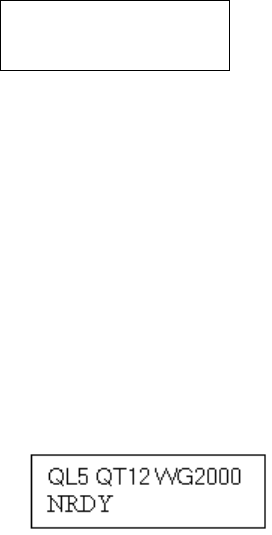
Phone Functions
IP 705 Manual 33
C
HAPTER
5
Phone Functions
The IP 705 provides a broad range of call handling and dialing features
directly on the phone and through the AltiWare system. The table in
“Supported Telephony Features” on page 34 lists the supported features, a
brief description of each, and configuration and use notes where applicable.
The LCD Screen
In normal operating mode, the phone’s LCD screen displays the time and
the extension number on the first line:
Other messages you may see:
MISSED xx - Number of calls missed.
xxVM - Indicates the number of new voice messages. Appears in place of
the extension number when there are voice messages.
If an activity code has been set on the phone, that code is displayed in place
of the extension number or voice mail count. Examples of activity codes
are MEETING, AWAY, TRAVEL.
DND or FWD - The extension has Do Not Disturb on or is set to forward
all calls.
Workgroup Status Display
When the IP 705 phone has been enabled to display workgroup status, and
the agent is in idle state, the LCD displays the following:
Figure 7. IP 705 Workgroup Display example
•QL = number of workgroup queued calls (up to 99)
•QT = current longest queue time (in seconds)
•WG = last four digits of the workgroup number
12:00 PM x555
MISSED xx DND

34 IP 705 Manual
The second line in the LCD displays one of the following agent states:
•LOUT - logout
•NRDY - not ready
•DND - do not disturb
•FWD - forwarding
The area is blank if the agent is in any other state.
When a call rings the agent or the when the agent is making an outgoing
call, the second line of the LCD is changed to Caller ID or dialed digits
display, and the first line stays the same. However, when more than one call
is outstanding, the first line shows the Call n/n display.
Supported Telephony Features
The following table lists additional features supported by the IP 705 phone.
Feature Description Configuration/Use Notes
Auto Answer When a call comes in, the
IP phone will ring for a
specified number of
seconds, connect the call,
and automatically answer
through the speaker or
headset.
•Phone’s menu path: PHONE
SETTING > AUTO ANSWER.
•During ringing, the user can
manually pick up the call from
headset, handset or speaker.
Auto Answer
Ring
When Auto Answer is set
to Yes, specifies how
many seconds the IP
phone should ring before
the call is automatically
answered (1-20 seconds).
•Phone’s menu path: PHONE
SETTING > AUTO ANS RING.
Number of seconds can be set
using /, or using the keypad
to enter a number (1-20).
Auto Answer
Dev
When Auto Answer is set
to Yes, specifies whether
the call should be
automatically answered
through the speaker or
headset.
•Phone’s menu path: PHONE
SETTING > AUTO ANS DEV.
Pressing / toggles
SPEAKER/HEADSET.

Phone Functions
IP 705 Manual 35
Busy Lamp
Field (BLF)
Associates programmable
key with an extension that
can be automatically
dialed when selected; the
key’s light indicates that
the extension is busy and
blinks when ringing.
The BLF ring tone is
played only when the
phone is in idle state. It is
stopped when the
destination phone stops
ringing or the local phone
exits idle state.
When multiple BLF
extensions ring
simultaneously, the IP
phone will play the first
BLF extension ringer and
beep tones and ignore
other BLF extensions.
•From AltiAdmin/ACM Admin,
go to AltiGen IP Phone
Configuration on the
Management Menu, go to the
desired extension, and set the
appropriate function key to BLF
and enter the extension in the field
below. The extension will be
associated with the corresponding
programmable key to
automatically dial this extension
number. Select the Play Beep
Tone checkbox to have the IP
phone play an audible beep or one
of 5 different ring tones when the
extension is ringing.
•The BLF feature can be assigned
only to internal extension
numbers, not outside numbers.
•The feature is not available in
Basic mode.
Call Log Shows the history of
incoming calls, up to 99.
•Feature does not require special
configuration to work. Pressing
the Enter button will dial the
number displayed. After 20
seconds without any input, the
phone will exit the Call Log.

36 IP 705 Manual
Call Record Allows a programmable
key to be used for on-
demand recording.
•From AltiAdmin/ACM Admin, go
to AltiGen IP Phone
Configuration on the
Management Menu, go to the
desired extension, and set the
appropriate function key to Call
Record.
•Go to the Extension
Configuration screen, General
page. In the Call Recording
Options field, select Record on
Demand to Extension VM or
Record on Demand to Central
Location.
•User presses the key to start
recording, presses the key again to
stop recording. There is no pause
function. When the call is
recording, the light is on.
•Recorded conversations can then
be played back through voice mail
or accessed at a centralized
location.
Conference
button
Initiates a conference and
adds in other parties one at
a time.
•Single Call Waiting, Multiple Call
Waiting or Live Call Waiting must
be enabled in AltiAdmin/ACM
Admin in order to conference
incoming calls.
•The user who initiates the
conference call can select another
conference member’s call and drop
it from the conference by
disconnecting the call. The feature
is unavailable to all other
conference members, even when
the conference initiator hangs up.
Workgroup
Status
Displays the workgroup
status in the LCD.
•From AltiAdmin/ACM Admin, go
to AltiGen IP Phone
Configuration on the
Management menu, go to the
desired extension, select IP 705
tab, and check the Display
Workgroup Status checkbox.

Phone Functions
IP 705 Manual 37
Flash button Signals PBX that special
instructions will follow.
•Press the Flash button.
Headset The 5th programmable
key can be programmed as
a Headset key. When
pressed, the user will be
able to activate the RJ-9
headset port.
•This button is used as a hook
switch for headset ports.
Hold button Places an active call on
hold.
•When multiple Call Waiting
Feature is enabled at the extension,
the user can put multiple incoming
calls on hold and retrieve using the
phone’s / buttons and Enter
button.
•Pressing Hold while onhook will
retrieve the last hold call.
•Supports up to 9 hold calls.
Line Park A parked call line
appearance can be
assigned as a
programmable Line Park
key by the administrator.
When connected to a
caller, the call can be
parked by pressing the
Line Park key. If a call is
parked at a Line Park line,
the button’s light is on.
The call can be picked up
by pressing the Line Park
key.
•Go to AltiGen IP Phone
Configuration on the
Management Menu, go to the
desired extension, and set the
appropriate function key to Line
Park.
•When configured by the
administrator, the IP phone can
play an audible beep or one of
several different ring tones when a
call is parked.
•When configured by the
administrator, an alternate way to
pick up a parked call is to use #51
<line number> if Line Park is not
assigned to a programmable key.
•The Line Park key’s light will be
lit and turns off when the parked
call is picked up, the caller hangs
up, or the call is routed to IVR/
Auto Attendant.
Mute button While on a call, mutes
conversation.
•Feature does not require special
configuration to work.

38 IP 705 Manual
Program
Keys
Lets users associate a
programmable key with a
speed dial number or
feature code directly from
the IP phone.
•In AltiAdmin, go to AltiGen IP
Phone Configuration on the
Management Menu, go to the
desired extension, and set the
appropriate function key to User
Defined #. The user will be able to
configure this key from the IP
phone menu, under PHONE
SETTINGS > PROGRAM KEYS.
Redial button Redials a selected number
from the last16 numbers
dialed.
•Feature does not require special
configuration to work. Pressing
Enter dials the number displayed.
•Redials up to 32 digits.
•When a new call comes in, the
phone will exit this menu and go to
ring state. If in this menu for longer
than 20 seconds without any input,
phone exits this menu.
Release
button
Releases a call from the
connected state. Deletes
characters entered on the
LCD. While onhook,
releases phone from an
active state.
•Feature does not require special
configuration to work.
Ring Tones Select from one of several
ring tones.
•Phone’s menu path: PHONE
SETTING > RING TONES, and
select from 0 - 4.
Program-
mable Keys
1 - 5
Key performs a specified
function (Busy Lamp
Field, AltiServ Feature
Code, Admin Defined #,
EXT Speed Dial, Line
Park, Call Record, User
Defined #, or Headset)
previously configured by
the system administrator.
•In AltiAdmin, go to AltiGen IP
Phone Configuration on the
Management Menu, select the
desired extension, and set the
appropriate programmable key to
the desired function (User Defined
# lets the user associate a
programmable key with a speed
dial number or feature code).
Speaker
button
Enables use of speaker
phone.
•Feature does not require special
configuration to work.

Phone Functions
IP 705 Manual 39
Transfer
button
Transfers an active call to
another number.
•Feature does not require special
configuration to work.
•This button cannot be used to
“flash” after being used to transfer
a call. To reconnect to a call after
using the Transfer button, use
thebutton or the Flash button.
Voice Mail
button
Enables access to voice
messages.
•The VM count that appears in the
LCD reflects new messages
(previously heard messages are not
included).
40 IP 705 Manual

IP 705 Manual 41
Appendix A
Specifications
Network
Protocols •H.323, RTP, RTCP, TFTP, TCP, UDP, DHCP, DNS, ARP,
ICMP, Telnet
Call Control
Protocols •H.323
Audio
Standards •Vocoder: ITU G.711 (PCM), two low bit rate (G.723.1 and
G.729A / G.729AB)
•Acoustic Echo cancellation supporting high-quality
speakerphone
Keypad
Features &
Handset
•12 standard dialing keys: 0-9, *, #
•11 Feature keys: Redial, Call Log, Hang-up/Release, Hold, Mute,
Flash, Transfer, Conference, Speaker, Voicemail, Volume
control.
•5 Function keys: can be set to N/A, Busy Lamp Field, AltiServ
feature code, speed dial, directory, line park, call recording,
phone setting, headset (Function key 5 only).
•Adjustable ringer/speaker/handset/headset volume control
LCD •2 x 16 Character LCD Display
•Provide features such as time, calling party name, calling party
number, digits dialed, extension number, number of new voice
mails, DND/FWD, missed calls, and system information.
LED •Voice Mail, Conference, Hold, Mute, Speaker
•Message waiting indicator in Voice Mail button
LAN •1 Standard 10/100 Base-T RJ-45 Port for network to phone
connection
Memory •Flash ROM: 4M, stores boot ROM, software imaging and
configuration data, DSP images.
•DRAM: 8M, stores runtime program and data.

Firewall Considerations
42 IP 705 Manual
Firewall Considerations
If using a firewall in the AltiWare environment, the following network
ports are used:
Headset •Headset RJ-9 port
Important: Contact AltiGen for the most current list of certified
headsets.
The pin outlet for headset support is:
Pin 1 (Tx-), Pin 2 (Rx1), Pin 3 (Rx2), Pin 4 (Tx+)
Note: If using Plantronics H91N or H101N headsets, a separate
Plantronics cable should be used and must be ordered
separately (part # 27190-01) in order to plug in these
headsets to the headset port.
Dimensions •(HxWxD) 8.23 x 8.74 x 1.65 in (209 x 222 x 42 mm)
Power •External power, 5VDC, 1.5A
•PoE option
Client Server TCP UDP
AltiAdminaAltiWare DCOM 135 135
AltiConsole AltiLink + 10025
AltiControl AltiLink+ 10025
AltiReach AltiLink 10015
AltiView/AltiAgent AltiLink+
VM Service
10025
10028
Supervisor AltiLink+
Internal/External CDR
Logger
10025
10027
CDRSearch AltiLink+
Internal/External CDR
Logger
10025
10027
10029
TAPI Client TAPI Gateway 10026
IP 705 AltiGen IP Phone Service 10032
VoIP H.323/H.225
GateKeeper
VoIP H.323/H.225 1720
1718, 1719
VoIP Message
Waiting
VoIP Message Waiting 49151

Appendix A
IP 705 Manual 43
Troubleshooting
The following table provides help for the most common problems an end
user may encounter. For IP 705 phone questions or problems not listed
here, contact AltiGen Technical Support.
VoIP H.245 VoIP H.245 From 49152 to Nb
VoIP RTP VoIP RTP From 49152 to Nb
VoIP ATPS VoIP ATPS 10032
Web Client AltiLink+
NetMeeting Chat
plus VoIP ports described
above
10025
1720
a. It is recommended that this be run only in an intranet.
b. N=49152+ (62*number of boards)–1
Problem/Symptom Solution
AltiWare is unreachable •Check to make sure the AltiWare IP address in the
IP phone is set up correctly.
•Check the IP 705 phone’s IP address, network mask
and default gateway.
•Check to make sure you can ping the IP 705 phone’s
address from AltiWare.
•Check to make sure the IP Phone Service is started
in AltiWare.
•Check AltiWare IP address in AltiAdmin IP Phone
Configuration menu.
Image update failed. If
setting Boot Download
to Yes, after the phone
reboots and if the setting
still says Yes, the boot
failed.
•Check the IP 705 phone’s IP address, network,
default gateway settings.
•Check the network connection.
•Check the TFTP server IP address and make sure the
TFTP server is running.
•PING from the TFTP server to the IP 705.
•Check to make sure app_705.bin and dsp.bin files
exist in TFTP server directory.
Client Server TCP UDP

Troubleshooting
44 IP 705 Manual
IP phone registered then
goes back to Basic mode
•Check network connectivity by pinging from
AltiServ to the IP phone.
•Check if IP Phone Service is running.
•Check if there is a duplicate IP address by
unplugging the Ethernet cable on the IP phone, then
pinging the IP 705 phone’s IP address.
•Check the extension’s IP address in AltiAdmin to
find out if another user is trying to log in using the
same extension number.
•Use #27 then Enter to log in again and see if the
problem persists.
No IP Address •Check if DHCP is enabled. If YES, check network
connection. If NO, verify that your DHCP server is
correctly configured.
•Check if IP 705 phone’s IP address is configured.
One way connection •Make sure firewall setting has all the TCP/UDP
ports required by AltiWare opened.
•If NAT is used, make sure NAT is enabled and NAT
address is set up correctly.
Phone does not show
anything on LCD display
•Check the power source to be sure the IP 705 phone
is receiving power.
Poor voice quality •Make sure a Layer 3 Managed Ethernet switch is
used, rather than a hub or non-managed switch, in
the corporate LAN.
•G.711 provides better voice quality.
•If VoIP is set up over WAN, set priority queuing on
the WAN router.
•Make sure WAN QoS is okay by pinging a few
hundred packets from remote site and observe
packet loss and network latency.
•Adjust jitter buffer to accommodate network
latency.

Appendix A
IP 705 Manual 45
Register failed •Check to make sure the extension number and
extension password are set up properly and that the
IP extension is enabled.
•Check to make sure the IP Phone Service is started
in AltiWare.
•If IP phone is associated with a physical phone (with
the same extension number), use #27 to activate the
IP phone to normal operating mode.
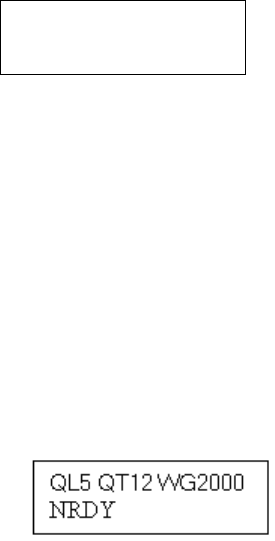
LCD Messages
46 IP 705 Manual
LCD Messages
Normal Operating Mode Messages
In normal operating mode, the phone’s LCD screen displays the time and
the extension number on the first line
MISSED xx - Number of calls missed.
xxVM - Indicates the number of new voice messages. Appears in place of
the extension number when there are voice messages.
If an activity code has been set on the phone, that code is displayed in place
of the extension number or voice mail count. Examples of activity codes
are MEETING, AWAY, TRAVEL.
Other messages you may see:
DND or FWD - The extension has Do Not Disturb on or is set to forward
all calls.
Workgroup Status Display
When the IP 705 phone has been enabled to display workgroup status, and
the agent is in idle state, the LCD displays the following:
Figure 1. IP 705 Workgroup Display example
•QL = number of workgroup queued calls (up to 99)
•QT = current longest queue time (in seconds)
•WG = last four digits of the workgroup number
The second line in the LCD displays one of the following agent states:
•LOUT - logout
•NRDY - not ready
•DND - do not disturb
•FWD - forwarding
12:00 PM x555
MISSED xx DND

Appendix A
IP 705 Manual 47
The area is blank if the agent is in any other state.
When a call rings the agent or the when the agent is making an outgoing
call, the second line of the LCD is changed to Caller ID or dialed digits
display, and the first line stays the same. However, when more than one call
is outstanding, the first line shows the Call n/n display.
Local Menu Configuration Messages
The following messages may be displayed in the LCD when accessing the
IP 705 phone’s menu:
Message Explanation
conf timeout! After 2 minutes inside the configuration menu, if no
action is taken, the LCD will show this message and then
quit the menu.
conf exception! During configuration, an unknown exception occurred.
Saved! The changed configuration was saved into memory.
Write Fail! Error occurred when saving the changed options into
flash ROM.
Wrong Ext Number! The inputted extension number is invalid.
Wrong input! User inputted an invalid value or string during
configuration.
wrong password! User is trying to configure an invalid password from the
phone menu.

LCD Messages
48 IP 705 Manual
IP Phone Running Messages
The following messages may be displayed in the LCD when running the
IP 705:
Message Definition
AW UNREACHABLE! Failed to connect to the AltiGen phone server. The user
is trying to register the IP phone with an invalid IP
phone’s IP address or the AltiGen Phone Server's IP
address is invalid.
Or, the network connection is lost in offhook or connect
state.
Refer to “AltiWare is unreachable” section of
“Troubleshooting” on page 43.
Basic-Idle IP phone is operating in Basic mode.
Press #27 again to reactivate.
Check IP Phone Service
Verify extension is configured for dynamic.
DHCP FAIL! Although DHCP was enabled, the IP 705 was not able to
receive the IP address from the DHCP server.
DUPLICATE IP! Another device configured with the same IP address as
the IP phone is detected. The IP phone cannot function
correctly until this is corrected.
INVALID IP!
INPUT AGAIN...
The inputted IP address is invalid.
INVALID VAL! During register of IP extension, an invalid response
(return value) returned from phone server.
NO IP ADDR! IP 705 cannot attach an IP address due to network
failure.
No Network! Phone has lost Ethernet connection.
REGISTER FAIL! Cannot register to the AltiGen phone server.
REGISTER OKAY! IP extension registered successfully.

Appendix A
IP 705 Manual 49
IP Phone Boot Messages
The following messages may be displayed in the LCD when booting the
IP 705:
REGISTERING... User entered #27 to manually register the IP extension.
REMOVE OLD EXT. When #27 is entered, the extension/password
configuration in the IP phone is removed.
WRONG PASSWORD! Registration failed because of invalid extension
password.
Message Definition
Boot Done The phone successfully booted.
CHECK FW Checking firmware.
CHECK MEMORY Checking memory.
INIT NETWORK Initializing network.
LOAD FAILED Failure to load the image into memory.
LOADING FW... Loading firmware.
LOADING NOW Loading firmware.
NETWORK FAILED. Network initialization failed.
TFTP FAIL! Failure downloading TFTP.
UPDATE FAILED. Firmware update failed.
UPDATE OK Firmware update successful.
update APP(S1) Appears when Boot Download is set to TRUE. The IP
705 will show this message when it is rebooted.
LCD Messages
50 IP 705 Manual

IP 705 Manual 51
Appendix B
User Reference
Basic Phone Operation
* Indicates a normal operating mode phone feature, which is available only after
registering the IP 705 with the phone server and logging in as an extension.
FUNCTION KEY SEQUENCE
Auto Answer 1) Press the Menu button, select PHONE SETTING, then
select AUTO ANSWER.
2) Use the / buttons to enable/disable Auto Answer mode,
and press Enter.
3) Select AUTO ANS RING from the menu.
4) Set the number of seconds to ring before auto answer (1-20),
and press Enter.
5) Select AUTO ANS DEV from the menu, then select from
speaker or headset as the Auto Answer device, and press
Enter.
Call Log* 1) With the phone onhook, press the Call Log button.
2) Use the / buttons to scroll to the number you want.
3) Press the Enter button to dial the number.
The Call Log stores up to 99 incoming numbers.

User Reference
52 IP 705 Manual
Conference* To initiate a conference during a call:
1) Press the Conference button (this automatically selects a
new line and places the other party on hold).
2) Enter the target telephone number.
3) When the call connects, press the Conference button again
OR the button to cancel the conference and return to the
original party.
The number of parties allowed in a conference call depends on
the AltiServ system. In general, up to 6 parties are allowed.
To conference an incoming call when no conference is in
progress:
1) Connect to a caller.
2) Get incoming call whose Caller ID or Caller Name is
displayed on the LCD. Call waiting tone is played.
3) Press the Enter button to answer caller and place the
original caller on hold.
4) Press the Enter button to select the original hold call.
5) Press the Conference button to create a conference and join
both callers.
If a conference is already in progress, to conference an
incoming call:
1) Press the Enter button to answer the incoming call (all other
conference members remain in conference).
2) Press the Enter button and select one of the members in
conference (displays “ConfHold”), then press the
Conference button to join the incoming caller to the
conference.
The user who initiates the conference call can select another
conference member’s call and drop it from the conference.
To drop a conference member:
1) Use the / buttons to select the member to disconnect.
2) Press the button to disconnect this caller.
•This feature is not available to other conference
members, even when the conference initiator hangs up.
Configuration
Menu •Press the Menu button to display the phone menu.
•Use the / buttons to scroll to the menu item you want.
•Use thebutton or Enter button to select a menu item or
setting.
•Use thebutton to return to the previous menu.

Appendix B
IP 705 Manual 53
Handset/
Headset/
Speaker
To switch between handset, headset and speaker, the user can
go offhook, or press the 5th programmable key if it is configured
for headset or press the Speaker button.
Hold* During a call:
1) Press the Hold button to put the current call on hold and
make a new call.
To retrieve a single call on hold:
1) Press the Hold button.
To retrieve multiple calls on hold:
1) Use / to select a hold call to be retrieved.
2) Press the Enter button.
OR
1) Press the Hold button to retrieve the last hold call.
Line Park During a call:
1) Press #51 and then enter the 2-digit Line Park line.
OR, press the Line Park key (if the administrator has
configured one). The Line Park key’s light will be lit and
turns off when the parked call is picked up, the caller hangs
up, or the call is routed to voice mail.
Mute While on a call with speaker, handset, or headset on:
1) Press the Mute button.
2) To disengage mute, press the Mute button again.
Program Key 1) Press the Menu button.
2) Select PHONE SETTING, then PROGRAM KEYS, then the
desired program key.
3) Enter the appropriate digits for the speed dial number or
feature code.
Reboot 1) Press * * 3, then the Enter button
Redial Phone is onhook
1) Press the Redial button.
2) Use / to scroll to the desired entry. ( scrolls to previous
entry, scrolls to first entry.)
3) Press the Speaker button or raise handset.
•Redial up to last 16 calls.
•Redial up to 32 digits.
Release For a connected call:
1) Press the Release button to hang up the call.
Also, press the Release button to exit the menu.

User Reference
54 IP 705 Manual
Restore
Default
Settings
1) Press the Menu button.
2) Press * * 2, then the Enter button.
Ring Tones 1) Press the Menu button.
2) Select PHONE SETTING, and scroll to RING TONES.
3) Select a ring tone and press the Enter button.
Program-
mable Key*
•N/A
•BLF
•Feature
Code
•Admin
Defined #
•EXT
Speed Dial
•Line Park
•Call
Record
•User
Defined #
•Headset
1) Press the appropriate programmable key (keys 1-5) to
initiate one of the following functions pre-assigned by the
system administrator: Busy Lamp Field, AltiServ Feature
Code, Admin Defined #, EXT Speed Dial, Line Park, Call
Record, User Defined #, Headset.
To configure a programmable key with Phone Setting
enabled:
a. Press the Menu button, select PHONE SETTING, and
press the Enter button.
b. Scroll to PROGRAM KEYS and press Enter.
c. Select the key to program, and press Enter.
d. Enter the appropriate digits for the speed dial number or
feature code, and press Enter.
The digits are automatically dialed when this function key is
pressed.
Speaker To use the speakerphone:
1) Press the Speaker button.
2) To disconnect the call, press the Speaker button again.
Transfer* During a call:
1) Press the Transfer button, which places the call on hold.
2) Dial the number you want to transfer the call to.
3) Hang up if the party answers the call, or press Transfer
again to complete transferring.
4) If the party refuses the call, return to the original call by
pressing the button or the Flash button.
Voice Mail 1) Press the Voice Mail button.
2) Enter voice mail password.
•The Message Waiting light blinks when a voice mail
message is waiting.
•The LCD displays the new voice mail count (which includes
only unheard messages) when onhook.

Appendix B
IP 705 Manual 55
* * Feature Codes
* * 2 . . . . . . . . . . . . . . . . . . . . . . . . . . . Restore default settings (when user is in the
Configuration Menu)
* * 3 . . . . . . . . . . . . . . . . . . . . . . . . . . . Reboot
AltiServ Feature Codes
## <pwd>. . . . . . . . . . . . . . . . . . . . . . . Log in to voice mail at your own station
### <ext> <pwd>. . . . . . . . . . . . . . . . . Log in to voice mail at another station
AltiGen Voice Mail System Quick Features
#11. . . . . . . . . . . . . . . . . . . . . . . . . . . . Greeting Menu
#28. . . . . . . . . . . . . . . . . . . . . . . . . . . . Password Menu
Making Calls
#34. . . . . . . . . . . . . . . . . . . . . . . . . . . . Dial By Name1
#35. . . . . . . . . . . . . . . . . . . . . . . . . . . . Virtual Log In (Station Privilege Override)
#69. . . . . . . . . . . . . . . . . . . . . . . . . . . . Dial Last Caller
#77. . . . . . . . . . . . . . . . . . . . . . . . . . . . Station Speed Dial
#88. . . . . . . . . . . . . . . . . . . . . . . . . . . . System Speed Dial
#99. . . . . . . . . . . . . . . . . . . . . . . . . . . . Last Number Redial
#93 <ext>. . . . . . . . . . . . . . . . . . . . . . . Intercom Call 2
Answering Calls
#29 <ext>. . . . . . . . . . . . . . . . . . . . . . . Individual Call Pickup (a specific station)
#30. . . . . . . . . . . . . . . . . . . . . . . . . . . . System Call Pickup (any station ringing)
Flash button #31 . . . . . . . . . . . . . . . . . Personal Call Park
#31 <ext>. . . . . . . . . . . . . . . . . . . . . . . Personal Call Park Pickup
Flash button #41 . . . . . . . . . . . . . . . . . System Call Park
#41 <loc. #>. . . . . . . . . . . . . . . . . . . . . System Call Park Pickup
#51 <line park line> . . . . . . . . . . . . . . . Line Park Pickup
#81. . . . . . . . . . . . . . . . . . . . . . . . . . . . Hands Free Intercom Mode
#82. . . . . . . . . . . . . . . . . . . . . . . . . . . . Hands Free Manual Answer Mode
Call Management
#26. . . . . . . . . . . . . . . . . . . . . . . . . . . . Station Log Out (Phone must be onhook)
Volume To adjust volume on handset/speakerphone/headset:
1) Depending on which volume you want to adjust, take the
phone offhook by lifting the handset, pressing the Speaker
button, or pressing the Headset button.
2) Press the Volume button. The device name and volume
level appear in the LCD.
3) Press the left side of the Volume button to decrease the
volume; press the right side to increase the volume.
To adjust ringer volume:
1) Leave the phone onhook.
2) Press the Volume button; a sample ring plays and the
volume level appears in the LCD.
3) Press the left side of the Volume button to decrease the
volume; press the right side to increase the volume.
1Feature must be enabled by system administrator.
2Feature available only on systems with Triton Analog Extension board or AltiGen IP phones.
User Reference
56 IP 705 Manual
#27 . . . . . . . . . . . . . . . . . . . . . . . . . . . Station Log In (Phone must be onhook)
#32 <acct code> . . . . . . . . . . . . . . . . . Enter Account Code (before dialing)
Flash button #32 <acct code> . . . . . . Enter Account Code (mid-call)
#33 . . . . . . . . . . . . . . . . . . . . . . . . . . . Do Not Disturb
#36 . . . . . . . . . . . . . . . . . . . . . . . . . . . Call Forwarding
#37 . . . . . . . . . . . . . . . . . . . . . . . . . . . Remote Call Forwarding
Other Features
#22 . . . . . . . . . . . . . . . . . . . . . . . . . . . Feature Status Check
#25 . . . . . . . . . . . . . . . . . . . . . . . . . . . Station Speed Dial Setup
#38 . . . . . . . . . . . . . . . . . . . . . . . . . . . Outside Call Blocking (operator only)
#39 . . . . . . . . . . . . . . . . . . . . . . . . . . . Operator Off-Line (operator only)
#44 . . . . . . . . . . . . . . . . . . . . . . . . . . . Overhead Paging
#45 . . . . . . . . . . . . . . . . . . . . . . . . . . . Overhead Paging by Trunk
#46 . . . . . . . . . . . . . . . . . . . . . . . . . . . Group Paging (for IP 705 phone users)
#55 . . . . . . . . . . . . . . . . . . . . . . . . . . . List Feature Tips
#73 . . . . . . . . . . . . . . . . . . . . . . . . . . . Silent System Call Park
#90 . . . . . . . . . . . . . . . . . . . . . . . . . . . Ready to receive workgroup calls
#91 . . . . . . . . . . . . . . . . . . . . . . . . . . . Not ready to receive workgroup calls
Flash button #40. . . . . . . . . . . . . . . . . Transfer to AltiGen Voice Mail System
Flash button # 15 <AA#>. . . . . . . . . . . Transfer to Auto Attendant
Flash button # # <ext> . . . . . . . . . . . . Transfer to a User’s Voice Mail
Flash button <ext> Flash button. . . . . Consultation
Dialing an IP Number Directly from the IP 705
To dial an IP number directly from the IP 705 phone set, enter the IP
address, using the * key to enter periods and followed by the # key.
Note: This works only when the IP 705 is operating in Basic mode.
If the IP 705 is configured for a public IP address, you can call other public
IP address devices. If the IP 705 is configured for a private IP address, you
can call other private IP address devices that you can “see” or that are on
your subnet.
IP 705 Manual 57
Glossary
A
ASCII - American Standard Code for Information Interchange.
B
Boot - to cause the computer to start executing instructions.
BPS - Bits Per Second. The number of bits transmitted per second.
C
configure - to determine and assign the equipment cabinet or chassis contents and
location of each card, as well as software parameters.
D
DHCP (Dynamic Host Configuration Protocol) - a protocol that lets network
administrators manage centrally and automate the assignment of Internet Protocol
(IP) addresses in an organization’s network.
DNS - Domain name system used to address translation to convert H.323 IDs,
URLs, or e-mail IDs to IP addresses. DNS is also used to assist in locating remote
gatekeepers and to reverse-map raw IP addresses to host names of administrative
domains.
Do Not Disturb (DND) - when this feature is selected, all incoming calls to the
user’s extension are denied. If the station has system forwarding instructions, the
calls will be automatically redirected to another extension, Attendant, or operator.
DTMF - Dual Tone Multi Frequency are the low and high frequency tones that
comprise touch tone signals.
DSP - Digital Signal Processor. A microprocessor with an architecture that is
particularly optimized to perform mathematical algorithms that manipulate digital
signals.
Dynamic IP Address - An IP address that is automatically assigned to a client
station in a TCP/IP network, typically by a DHCP server. Network devices that
serve multiple uses, such as server and printers, are usually assigned static IP
addresses.
Dual Tone Multi Frequency - see DTMF.
58 IP 705 Manual
E
extension number - an arbitrary number of two to five digits that matches a station
to a particular user.
F
Firewall - a set of related programs, located at a network gateway server, that
protects the resources of a network from users of other networks.
FLASH - a sudden brief signal. Activated by pressing the Flash button, or by a
quick press and release of the receiver button (switch hook).
FXS - Foreign Exchange Subscriber. An analog interface for direct connection of a
telephone set to a digital multiplexer.
G
Gateway - allows H.323 terminals to communicate with terminals configured to
other protocols by converting protocols. A gateway is the point where a circuit-
switched call is encoded and repackaged into IP packets.
GMT - Greenwich Mean Time. Mean solar time of the meridian at Greenwich,
England, used as the basis for standard time throughout the world.
H
H.323 - An International Telecommunications Union (ITU-T) standard that
describes packet-based video, audio and data conferencing.
http or HTTP - Hypertext Transfer Protocol. The Internet protocol used to manage
communications between Web clients (browsers) and servers.
I
IMAP4 - Internet Message Access Protocol - Version 4.
IP 705 - An AltiGen H.323-compliant, business telephone that provides voice
communication over an IP network.
IP Address - a 32-binary digit number that identifies each sender or receiver of
information that is sent in packets across the Internet.
ISP - Internet Service Provider.
J
jack - the mate for a plug. Used to connect two pieces of equipment together.
Glossary
IP 705 Manual 59
K
keyboard - system interface for communication. A group of numeric keys,
alphabetic keys, or function keys used for entering information into a terminal and
into the system.
L
Local address - an address used in a peripheral node or station in place of a network
address and transformed to or from a network address for delivery purposes.
Logoff - the procedure by which a user disconnects from a program or session.
Logon - the procedure by which a user begins a program or terminal session and
gains access to the AltiServ or Quantum system.
M
MHz - Megahertz.
ms - millisecond.
N
NAT (Network Address Translation) - translation of an Internet Protocol address
(IP address) used within one network to a different IP address known within another
network. One network is designated the inside network, the other is the outside.
network - A configuration of data processing and/or telecommunication devices
and software connected for information exchange.
network address - An identifier for a node, station, or unit of equipment in a
network.
network domain - a set of workstations and servers that share a security account
manager database and can be administered as a group. A user with an account in a
particular network domain can log onto and access his or her account from any
system in the domain.
network mask - also known as the subnet mask.
network server - networking software that responds to I/O or computes requests
from a client machine. Windows NT network servers can be implemented either as
server processes or as drivers.
O
offhook - refers to the phone when the receiver is not resting in the base.
60 IP 705 Manual
One Number Access - a feature of AltiWare that allows users to create a list of
phone numbers that the system can use to track users and connect them with an
incoming call if they are not at their extension desk.
onhook - the term used to describe a telephone in the idle state or with the receiver
still resting in the base.
P
physical extension - is associated with a physical port and device. An extension is
created, by default, as a physical extension (as opposed to a virtual or workgroup
extension) unless there are no more physical ports available.
ping (Packet InterNet Groper) - a program used to test whether a particular
network destination on the Internet is online by repeatedly bouncing a signal off a
specified address.
port - a communication channel through which a client process communicates with
a protected subsystem.
protocol - A set of rules and conventions by which two computers pass messages
across a network medium. Networking software generally implements multiple
levels of protocols layered one on top of the other.
Q
queue - a collection of calls waiting to be served. Queued calls in AltiWare are
handled on a first-in, first-out basis.
R
RAS - Remote Access Service.
RJ-11 - The common telephone jack. Usually wired with four wires, the red and
green signify the tip and ring circuits.
RJ-45 - A jack for data cables. Usually wired with eight wires.
router - protocol-dependent device that connects subnetworks together.
S
server - any computer whose function in a network is to provide user access to files,
printing, communication, and other services.
static IP address - a permanent IP address that is assigned to a node in a TCP/IP
network.
Glossary
IP 705 Manual 61
subnet mask - the method used for splitting IP networks into a series of subgroups,
or subnets. The mask is a binary pattern that is matched up with the IP address to
turn part of the host ID address field into a field for subnets.
System Speed Dialing - this feature allows the user to access a list of commonly
called phone numbers entered into the system by the administrator. The user presses
the SpeedDial button on the phone, selects a number from the list, and then dials by
pressing the Enter button.
T
TCP/IP - Transmission Control Protocol/Internet Protocol. A full set of protocols
used on the Internet.
TDM - Time Division Multiplexing.
TFTP (Trivial File Transfer Protocol) - a version of the TCP/IP FTP protocol that
has no directory or password capability.
transfer - this feature redirects a call to another extension, the AltiGen Voice
Mail System, or operator.
U
UDP (User Datagram Protocol) - a communications protocol that offers a limited
amount of service when messages are exchanged between computers in a network
that uses the Internet Protocol.
URL (Uniform Resource Locator) - the address that defines the route to a file on
the web or any other Internet facility.
user(s) - the person or persons accessing the features and functions of the AltiWare
product.
V
virtual extension - an extension not associated with a physical port that allows for
guest access to the AltiGen Voice Mail System features and telephone sharing
environments. Users of a virtual extension have to log in before accessing the
system features assigned to it.
VoIP - voice over Internet Protocol (IP). The technology used to transmit voice
conversations over a data network using the Internet Protocol.
62 IP 705 Manual
W
workgroup - telephones arranged in groups within a particular organizational
function (for example, marketing, sales, service, etc.). Each workgroup is assigned
a pilot number. When the pilot number is dialed, the system scans the list of
extensions comprising the workgroup and connects the call to the first available idle
extension number. If no extensions are available, the call is placed in that
workgroup’s queue.
workgroup pilot number - an extension designated to a workgroup that is not
associated with a physical port and may consist of up to 64 members. When the pilot
number is dialed, the call is distributed to the workgroup members.
Index
IP 705 Manual 63
Index
A
activating IP phone extension 16
AltiAdmin/ACM Admin configura-
tion requirements 7
AltiGen Communications
contact information ii
AltiGen IP Phone Service 8
AltiWare Server, setting IP
address 24
assigning
a local IP address 27
a TFTP server 27
NAT 29
audio standards 41
auto answer 34
device 34
ring 34
B
Basic mode 8
BLF, configuring 14, 35
Boot Download 25
Busy Lamp Field, configuring 14,
35
C
call control protocols 41
Call Log button 2, 35
Call Record button, using 36
call record, configuring 15, 36
Conference button, using 36
configuration requirements
AltiAdmin/ACM Admin 7
configuring
AltiWare vs IP phone 15
from IP phone menu 23
in AltiAdmin/ACM Admin 10
IP settings 27
NAT 29
D
debugging 12
default settings, restoring 20
DHCP, enabling/disabling 25, 26
dial pad 3
dialing IP number 56
dimensions, IP 705 phone 42
display workgroup status 36
distinctive ring options 30
E
emergency gateway, setting 25
emergency number, setting 25
Enter button 2
EXT Speed Dial 14
extension
activating IP phone 16
number, setting 23
password, setting 23
F
feature code, configuring 14
features, list of 33
firewall
network ports 42
port configuration 8
firmware, updating 28
firmware, upgrading 25
Flash button 3
G
GateKeeper Discovery, enabling/
disabling 25
gatekeeper, enabling/disabling 25
gateway, setting IP address 25
H
handset port 5
hardware components 6
headset
port support 42
Headset button, using 37
headset port 5

Index
64 IP 705 Manual
headset programmable key,
configuring 15
Hold button, using 37
I
installing IP 705
locally 9
remotely 17
IP 705 phone
functions, list of 33
hardware components 6
illustration 1, 4, 5
overview 1
registering 26
specifications 41
time display 12
IP address
assigning a local 27
inputting in LCD 27
IP number, dialing 56
IP settings, configuring 27
J
jitter buffer 11
K
keys, feature 41
L
LAN ports 41
LCD messages, explained 46, 48, 49
LCD screen 2, 41
LED, in buttons 41
line park, configuring 14, 37
local address, setting 25
logon, to extension in use 19
M
memory, IP 705 phone 41
Menu button 3
message waiting light 2
Mute button 37
N
NAT
address, setting 26
assigning 29
configuring 29
enabling/disabling 26
navigation buttons 2
network
mask, setting 25
protocols 41
requirements 7
settings, configuring from
phone 25
normal operating mode 8
O
operating mode
Basic 8
normal 8
P
password, setting extension 23
periods, inputting in LCD 27
phone operation 51
phone startup, verifying 18
plug and play 8
setup after starting phone 19
PoE module 6
installing 20
removing 21
power over Ethernet
module 6
using 20
power, IP 705 phone 42
programmable keys
configuring 14
R
rebooting 20
Redial button 38
registering IP phone 26
Release button 2, 38
remote installation 17
Index
IP 705 Manual 65
restoring default settings 20
ring tones, setting 30, 38
S
service, getting vi
settings, restoring default 20
setup, IP 705 9
Speaker button 38
specifications 41
speed dial 14
administrator configuration 14
user configuration 15
startup
verifying phone 18
system requirements 7
system settings, configuring from
phone 24
T
TFTP server
assigning 12, 27
setting IP address 24
time display 12
time offset, setting 24
Transfer button 39
troubleshooting 43
U
updating phone firmware 28
User Defined # 15
user reference 51
V
verifying phone startup process 18
version information 25
Voice Mail button 2, 39
W
warranty v
how to get service vi
workgroup queue status, configuring
display 36
workgroup queue status,
displaying 31